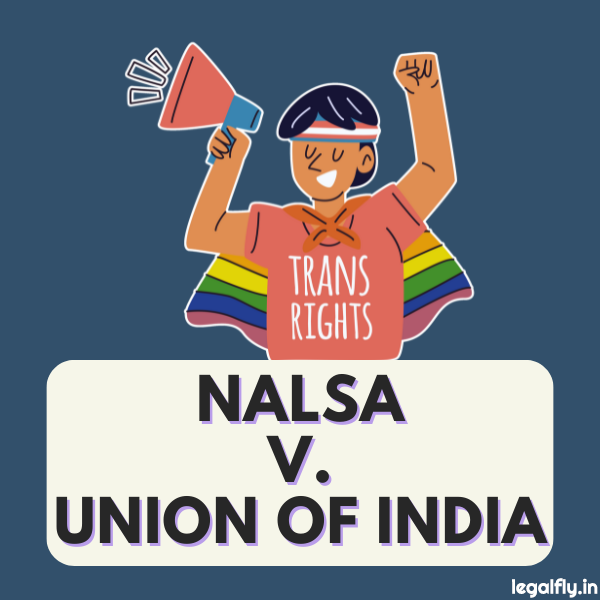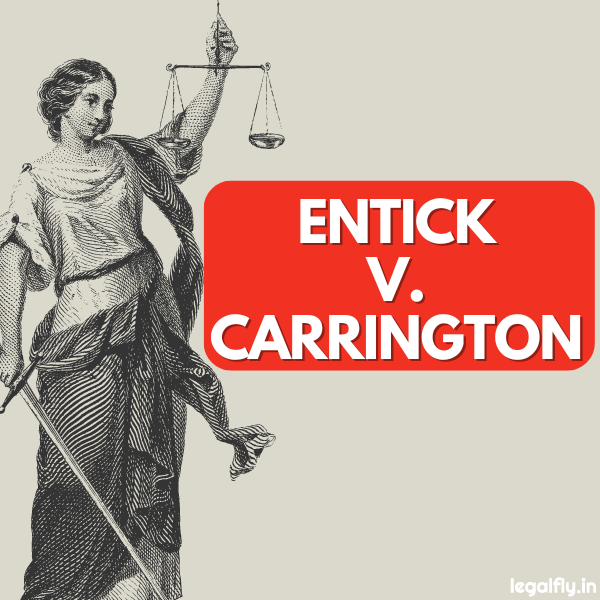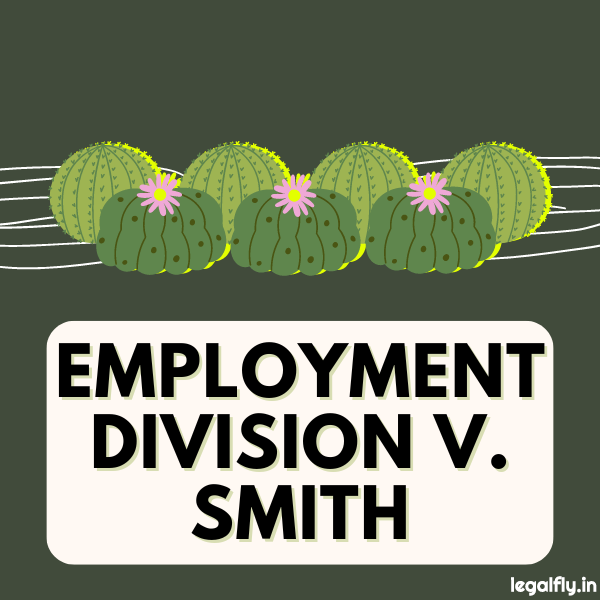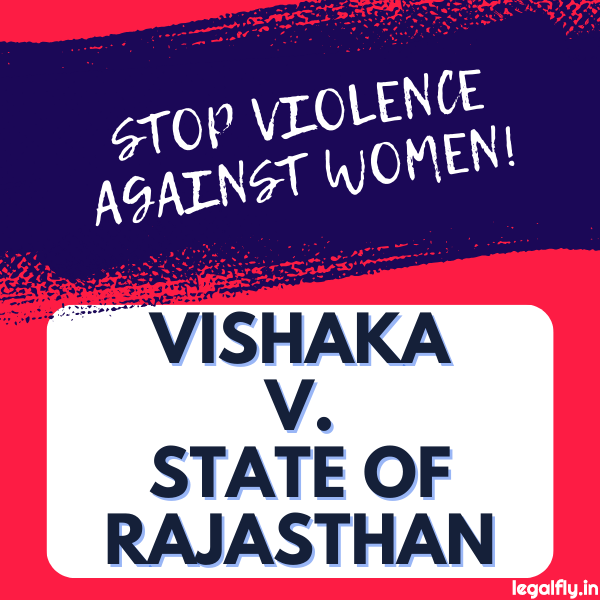Table of Contents
Case Name: National Legal Services Authority v. Union of India
Court: Supreme Court of India
Year: 2014
Citation: AIR 2014 SC 1863
Introduction
In a landmark ruling, the Supreme Court of India recognised transgender people as the ‘third gender’ in the case of NALSA v. Union of India. This historic judgement affirmed that the fundamental rights under the Constitution of India are equally applicable to transgender individuals. Doing so empowered them with the right to self-identify their gender as male, female, or third gender, ensuring their dignity and freedom.
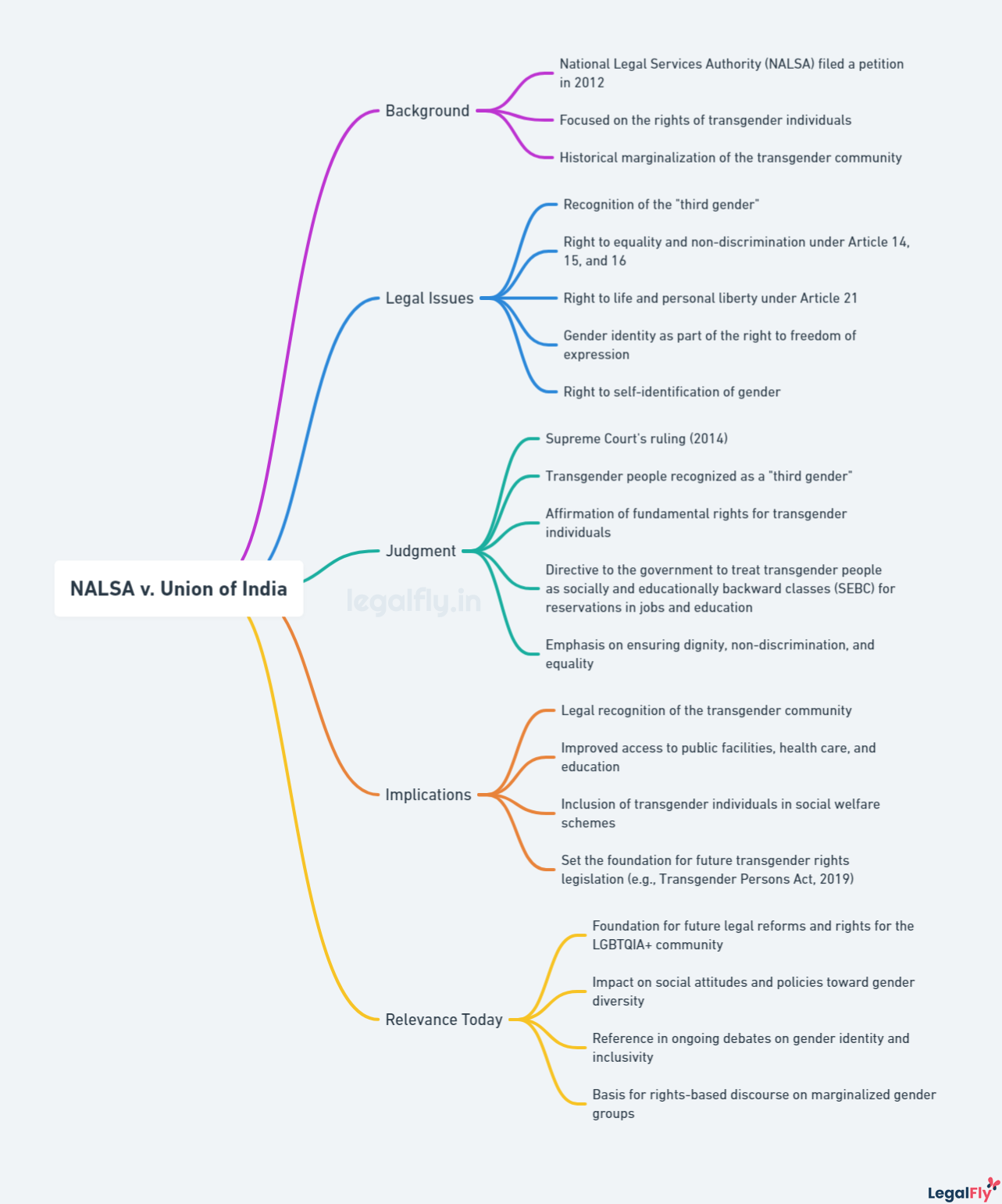
The NALSA judgement directed the Central and State governments to take proactive steps in securing the rights of transgender persons. This includes policies for educational and employment opportunities and access to healthcare and social welfare. Recognising the high HIV prevalence among transgender communities highlighted in recent studies, the Court’s decision also aims to address significant health disparities.
This judgement marks a significant shift in India’s legal and social landscape. It not only acknowledges the historical and social context of transgender people but also lays the groundwork for future legal and social advocacy to improve their lives. Doing so sets a precedent for further progress in recognising and protecting the rights of all marginalised communities.
Key Takeaways
- The Supreme Court of India recognised transgender individuals as the ‘third gender‘.
- The judgement ensures that fundamental rights are equally applicable to transgender people.
- Proactive steps were directed to secure the rights and opportunities of transgender persons.
Historical and Social Context
Transgender people in India have faced significant social and legal challenges over time. Historical records show the existence of the Hijra community, but societal attitudes have often been discriminatory.
The Status of Transgender People in Society
Transgender individuals in India, often referred to as Hijras and eunuchs, have existed for centuries. Historically, they held respected roles within society, particularly during the Mughal era, where they were trusted to work in royal courts. This reverence, however, diminished over time.
In modern times, the Transgender Community has largely been marginalised. They often face rejection from families and communities, leading to social exclusion. This exclusion impacts their access to education, healthcare, and employment. Many are forced into begging or sex work as their primary means of livelihood. The social stigma surrounding transgender individuals further entrenches their marginalisation, with societal norms often treating them as outcasts.
Legal and Social Discrimination
The legal landscape for transgender individuals in India has historically been harsh. They were criminalised under various laws, including colonial-era statutes, reinforcing social discrimination. They faced harassment from law enforcement and had few legal protections against violence and abuse.
The landmark judgement in NALSA v. Union of India 2014 marked a significant turning point. The Supreme Court recognised the rights of transgender individuals, affirming their right to self-identify as male, female, or third gender. This ruling was crucial in acknowledging their constitutional right to equality and freedom from discrimination. Nonetheless, implementing these legal rights remains challenging, and social discrimination continues to affect the transgender community’s daily lives.
Constitutional Rights and NALSA Judgement
The NALSA v. Union of India case was pivotal in affirming the rights of transgender people in India. This section breaks down the constitutional rights recognised by the judgement and its key provisions, along with the impact on the legal recognition and rights of transgender individuals.
Fundamental Rights and the Constitution of India
The Constitution of India grants fundamental rights to every citizen. Article 14 ensures equality before the law, while Article 21 guarantees the right to life and personal liberty. These provisions are essential in recognising the rights of transgender people. Before the NALSA judgement, transgender individuals faced social exclusion and discrimination, denying them basic rights and protections under the law.

Article 14’s promise of equality and Article 21’s protection of personal liberty became crucial in the Supreme Court’s decision. The judgement reasserted that these rights apply equally to transgender individuals, affirming that they deserve the same legal protections as any other citizen.
Key Provisions of NALSA v. Union of India
The NALSA v. Union of India case provided several key provisions that aimed to uplift transgender individuals. The judgement recognised them as the ‘third gender,’ marking a significant step towards their social and legal acceptance.
It also affirmed their right to self-identify as male, female, or third gender. This provision empowered transgender people to have their identities legally acknowledged without the need for medical procedures. Moreover, the court directed the government to take measures to eliminate the discrimination faced by transgender individuals and to provide them with benefits and welfare schemes.
Impact on Legal Recognition and Rights
The NALSA v. Union of India judgement had a profound impact on the legal recognition of transgender individuals in India. It mandated legal recognition of gender identity based on self-identification rather than surgical or medical procedures. This was a significant step towards respecting the autonomy and dignity of transgender people.
Furthermore, the decision has led to increased awareness and better implementation of policies aimed at protecting transgender rights. It has influenced other legal reforms and prompted various states to develop welfare schemes specific to transgender individuals. This legal recognition has helped to improve access to education, employment, and healthcare for transgender persons.
Policies and Implementation
Policies and efforts to protect transgender rights in India stemmed from the landmark NALSA decision, which granted transgender individuals the right to self-identify their gender. Governments and civil society organisations have since played crucial roles in policy creation and implementation.
Government Initiatives and Social Welfare Schemes
The Ministry of Social Justice and Empowerment has been at the forefront of creating policies to support transgender individuals. Following the NALSA judgment, the government introduced various social welfare schemes aimed at improving education, employment, and healthcare for the transgender community.
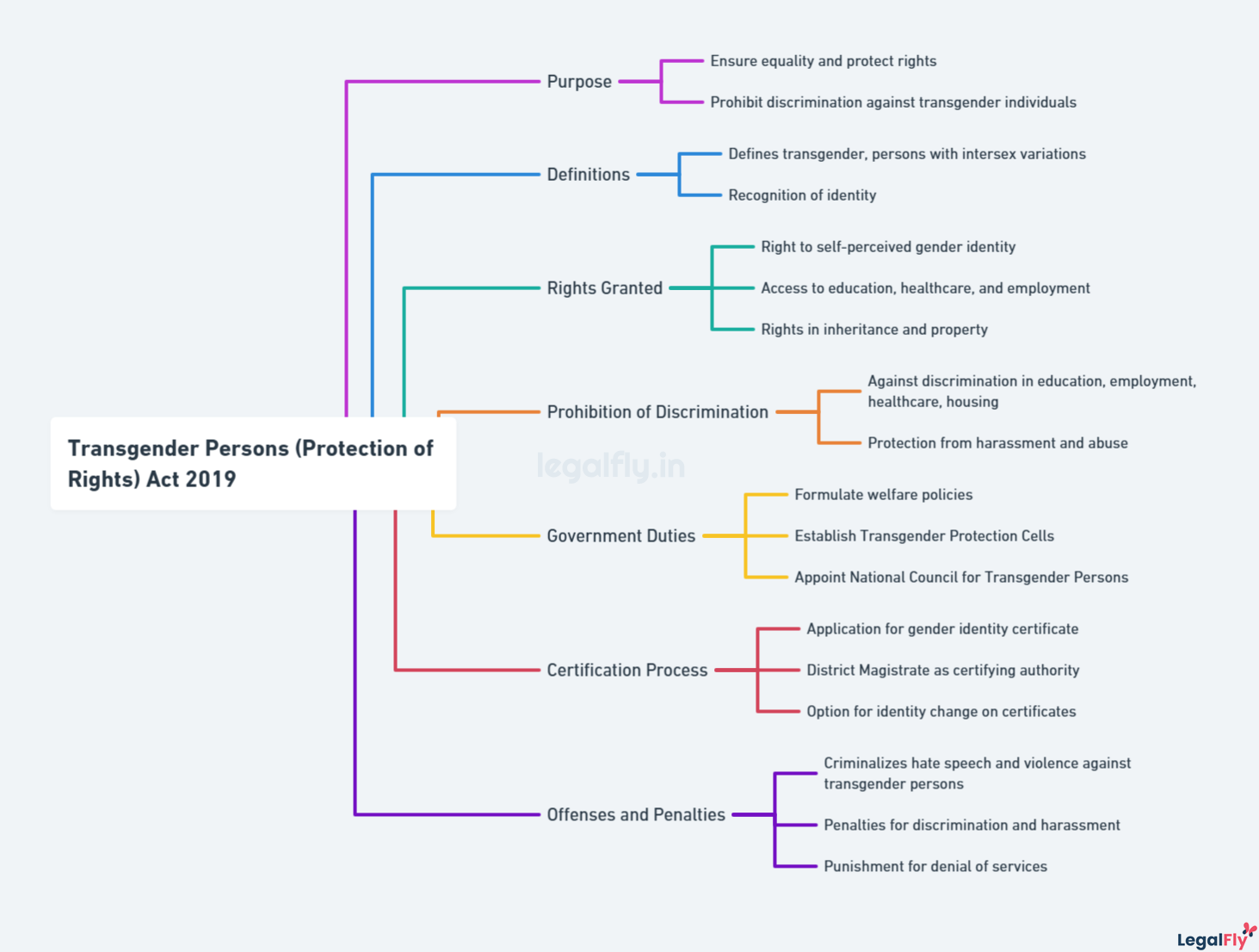
One significant initiative is the Transgender Persons (Protection of Rights) Act, which mandates equal rights and eradicates discrimination against transgender persons. The government also launched policies for housing and financial support, along with vocational training programmes to enhance their employment opportunities.
Role of NGOs and Civil Society
Non-Governmental Organisations (NGOs) and civil society are pivotal in supporting transgender rights. They work to bridge the gap between policy and practice, ensuring the development and execution of welfare programmes. These organisations assist in spreading awareness, offering legal aid, and providing counselling services to the transgender community.
NGOs also collaborate with government bodies like the National Legal Services Authority of India, ensuring effective implementation of laws and tackling issues at the grassroots level. They conduct workshops and public outreach programs aimed at changing societal attitudes towards transgender people.
Challenges in Policy Execution
Despite the progressive policies, challenges remain in their effective implementation. There are gaps in public awareness and understanding, often resulting in continued discrimination and social exclusion. Legal protections need stronger enforcement to be truly effective.
Moreover, there is a lack of infrastructure and insufficient coordination among various government departments, which hampers the execution of social welfare schemes. Additionally, societal stigma and reluctance to accept transgender individuals in mainstream settings pose significant hurdles.
Addressing these issues requires collaborative efforts from both government bodies and civil society to create an inclusive and supportive environment for transgender individuals.
Educational and Employment Opportunities
Transgender people in India face significant challenges in accessing education and employment opportunities. This section discusses the initiatives aimed at improving reservations and accessibility in education, as well as equality in employment and job security.
Reservations and Accessibility in Education
Transgender individuals have been granted reservations in educational institutions. The Supreme Court of India’s decision in the NALSA v. Union of India case has paved the way for better integration of transgender people into the educational system. This ruling mandated that educational institutions must treat transgender students with dignity and provide necessary support.
Reservations for transgender students ensure they have opportunities similar to other minority groups. This includes reserved seats in schools, colleges, and universities.
Improving accessibility also involves modifying curricula to be inclusive and providing counselling and support services to help transgender students overcome barriers.
Equality in Employment and Job Security
Employment opportunities for transgender people have been historically limited. The NALSA v. Union of India case recognised the need for legal protections in workplaces to prevent discrimination. They are now entitled to work in any field without fear of unfair treatment or dismissal based on their gender identity.
Job security measures have been introduced to protect transgender employees. This includes anti-discrimination policies and sensitisation programmes for employers and staff.
Equality in employment also involves creating job reservations in government jobs, giving transgender people fair chances to build careers. Support systems such as job training and placement services are crucial in helping transgender individuals find and retain work.
Legal and Social Advocacy
In the fight for the rights of transgender people in India, both legal services and social advocacy play crucial roles. From the involvement of high-profile activists to landmark court cases, multiple efforts have been made to ensure equality and justice.
Legal Services and Support for Transgender People
The Supreme Court’s decision in NALSA v. Union of India was a milestone. It affirms the rights of transgender people to self-identify their gender and prompted the establishment of various legal services aimed at protecting these rights.
Legal services provided to transgender individuals include legal aid, counselling, and representation in courts. The National Legal Services Authority has been instrumental in offering such support. Additionally, organisations like the Delhi High Court Legal Services Committee provide specialised assistance to ensure equal access to justice.
Employing a team of dedicated lawyers and social workers, these bodies focus on addressing issues like discrimination, violence, and wrongful termination of employment. In Karnataka, the Karnataka State Legal Services Authority has made significant strides in offering such support.
Prominent Activists and Landmark Cases
Activists like Grace Banu and Vyjayanti Vasanti Mogli have been at the forefront of social advocacy for transgender rights in India. Their efforts range from public campaigns to lobbying for legal reforms.
Grace Banu, a prominent activist from Tamil Nadu, fights against discrimination in education and employment. She has also worked tirelessly to push for the implementation of the Supreme Court’s directives regarding transgender rights.
In Telangana, Vyjayanti Vasanti Mogli has been a vocal advocate, addressing the community’s issues through both legal channels and public awareness campaigns. Jayna Kothari, a Supreme Court lawyer, has argued several significant cases that have contributed to the evolving legal landscape for transgender people.
Their advocacy has had a substantial impact, both legally and socially, helping to change public perceptions and promote inclusivity.
Frequently Asked Questions
What was the NALSA v. Union of India case about?
NALSA v. Union of India was a landmark 2014 Supreme Court case addressing transgender rights in India. The National Legal Services Authority (NALSA) filed a petition seeking legal recognition of transgender individuals as a third gender and protection of their fundamental rights. The case challenged the binary gender system and sought equal treatment for transgender persons under the Indian Constitution.
What was the Supreme Court’s ruling in NALSA v. Union of India?
The Supreme Court ruled in favour of transgender rights, recognizing them as a “third gender” and affirming their fundamental rights under the Constitution. The Court held that individuals have the right to self-identify their gender as male, female, or third gender. It directed the government to treat transgender persons as socially and economically backward classes eligible for reservations in education and employment.
How did NALSA v. Union of India impact transgender rights in India?
NALSA v. Union of India significantly advanced transgender rights in India. It granted legal recognition to the third gender, affirmed transgender individuals’ right to self-identification, and extended constitutional protections to them. The ruling mandated governments to implement welfare schemes for transgender persons, provide separate public toilets, and address discrimination. This judgment laid the foundation for subsequent transgender rights legislation and policies in India.

